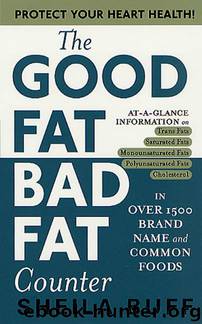The Good Fat, Bad Fat Counter by Sheila Buff

Author:Sheila Buff
Language: eng
Format: epub
Published: 2019-03-30T16:00:00+00:00
Chapter Two
THE BAD FATS
Saturated fat and cholesterol fall into the “bad” fats category, but that description is actually a little harsh. Saturated fat in moderation is perfectly healthy, as is cholesterol. In fact, cholesterol is extremely important for your overall health. These fats become bad only when you eat too much of them, especially if you eat them as part of an overall diet that’s high in trans fats and low in good fats.
SATURATED FAT IN YOUR DIET
Saturated fats are “hard” fats—they’re generally solid or semisolid at room temperature. Good examples are butter, tallow (beef fat), and lard. Some tropical oils, such as coconut oil, are liquid at room temperature but still very high in saturated fat.
All fats, however, are really mixtures of saturated and unsaturated fatty acids. Animal fats, such as lard and butter, are high in saturated fat, but they also contain high amounts of monounsaturated fat. In fact, lard has more monounsaturated fat than saturated fat per serving. Like all animal fats, lard contains some cholesterol (12 milligrams per 1-tablespoon serving), but it has far more monounsaturated fat than the supposedly more healthful vegetable oils such as soybean or corn.
Meat, poultry, eggs, fish, shellfish, and whole-milk dairy products, such as cheese and butter, contain saturated fat and cholesterol. Dishes made using these basic ingredients will contain saturated fat and cholesterol as well. Fruits, vegetables, and grains have no or very little saturated fat; nuts have some, but not a lot, and plenty of good fats that more than compensate.
Although animal foods such as beef usually are considered as sources of only saturated fat, the fat in these foods is also a mixture of saturated, monounsaturated, and polyunsaturated fat. A 3.5-ounce broiled hamburger, for instance, contains 19.7 grams of fat. Of that, 7.7 grams is saturated fat, but 8.6 grams is monounsaturated fat. Likewise, a 3.5-ounce pork chop has 22.1 grams of fat. Of that, 8.0 grams is saturated fat and 10.2 grams is monounsaturated fat.
Sometimes tropical oils, such as palm oil, coconut oil, and palm kernel oil, are used in cookies, crackers, other baked goods, and nondairy creamers, often in place of partially hydrogenated vegetable oil (trans fat). Because these tropical oils are highly saturated, consumer outcry has led many food manufacturers to remove them and replace them with trans fat. But substituting trans fats for tropical oils isn’t really more healthful at all—in fact, it’s worse.
What makes saturated fat so bad for you? That’s a good question—and one that doesn’t have a clear answer yet. In general, however, research that looks at large groups of people has consistently shown that overall, the people who eat the most fat of all kinds also tend to have the most heart disease. The research behind the recommendations to cut dietary fat is not without controversy, however. Some of the original studies, such as the famous Seven Countries study done in the 1950s, didn’t take into account cigarette smoking and other risk factors and also looked very selectively at some of the data.
Download
This site does not store any files on its server. We only index and link to content provided by other sites. Please contact the content providers to delete copyright contents if any and email us, we'll remove relevant links or contents immediately.
How to Be a Bawse: A Guide to Conquering Life by Lilly Singh(6703)
Deep Work by Cal Newport(5501)
The Longevity Diet by Valter Longo(4454)
The Fat Loss Plan by Joe Wicks(4245)
The Four-Pack Revolution by Chael Sonnen & Ryan Parsons(3487)
The Ultimate Bodybuilding Cookbook by Kendall Lou Schmidt(3328)
The French Women Don't Get Fat Cookbook by Mireille Guiliano(2987)
Super Food Family Classics by Jamie Oliver(2915)
Turn Up Your Fat Burn! by Alyssa Shaffer(2814)
Factfulness_Ten Reasons We're Wrong About the World_and Why Things Are Better Than You Think by Hans Rosling(2759)
Not a Diet Book by James Smith(2742)
Tom Kerridge's Dopamine Diet: My low-carb, stay-happy way to lose weight by Kerridge Tom(2682)
Body Love by Kelly LeVeque(2633)
Self-Esteem by Matthew McKay & Patrick Fanning(2609)
The Unbecoming of Mara Dyer by Michelle Hodkin(2488)
Tone Your Tummy Type by Denise Austin(2372)
The Fat Chance Cookbook by Robert H. Lustig(2324)
LL Cool J's Platinum 360 Diet and Lifestyle by LL Cool J(2315)
Men's Health Best by Men's Health Magazine(2099)
